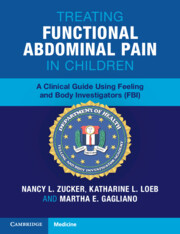 Treating Functional Abdominal Pain in Children
Treating Functional Abdominal Pain in Children Book contents
- Treating Functional Abdominal Pain in Children
- Treating Functional Abdominal Pain in Children
- Copyright page
- Dedication
- Contents
- Acknowledgements
- Part I The Background Science Behind Feeling and Body Investigators
- Chapter 1 Becoming a Feeling and Body Investigator – Pain Division
- Chapter 2 Visceral Sensitivity as a Superpower
- Chapter 3 Responsive Parenting and Creating Safety
- Chapter 4 Discriminating Safe from Threatening Body Sensations: The Science of Interoceptive Exposures
- Chapter 5 The Medical Evaluation of Abdominal Pain in Children – One General Pediatrician’s Approach
- Part II A Session-by-Session Guide to Feeling and Body Investigators
- Part III Sample Workbook Pages, Handouts, and Additional Resources for Feeling and Body Investigators
- Index
- References
Chapter 1 - Becoming a Feeling and Body Investigator – Pain Division
from Part I - The Background Science Behind Feeling and Body Investigators
Published online by Cambridge University Press: 18 November 2023
- Treating Functional Abdominal Pain in Children
- Treating Functional Abdominal Pain in Children
- Copyright page
- Dedication
- Contents
- Acknowledgements
- Part I The Background Science Behind Feeling and Body Investigators
- Chapter 1 Becoming a Feeling and Body Investigator – Pain Division
- Chapter 2 Visceral Sensitivity as a Superpower
- Chapter 3 Responsive Parenting and Creating Safety
- Chapter 4 Discriminating Safe from Threatening Body Sensations: The Science of Interoceptive Exposures
- Chapter 5 The Medical Evaluation of Abdominal Pain in Children – One General Pediatrician’s Approach
- Part II A Session-by-Session Guide to Feeling and Body Investigators
- Part III Sample Workbook Pages, Handouts, and Additional Resources for Feeling and Body Investigators
- Index
- References
Summary
Functional abdominal pain (FAP) is one of the most common medical complaints children present to their pediatricians. Despite the prevalence of FAP as well as its early onset, treatments for young children are particularly rare. Young children are just beginning to learn about the complex messages that their body communicates. Yet, pain can contribute to a fear of the body and an attempt to avoid these important signals. This chapter describes the background and rationale for a new approach to pain for young children, one that conceptualizes the sensitivity to pain and other experiences of the body as a superpower rather than a vulnerability - “sensory superpowers!” We train children to be Feeling and Body Investigators (FBI), individuals who have awe-inspiring curiosity and responsivity towards the many wise communications from their bodies and who respond to these messages with dexterity and skill. The end result is children who are not only fearless about pain, but also who are adept at emotion awareness and regulation. They are Feeling and Body Investigators!
Keywords
- Type
- Chapter
- Information
- Treating Functional Abdominal Pain in ChildrenA Clinical Guide Using Feeling and Body Investigators (FBI), pp. 1 - 8Publisher: Cambridge University PressPrint publication year: 2023


